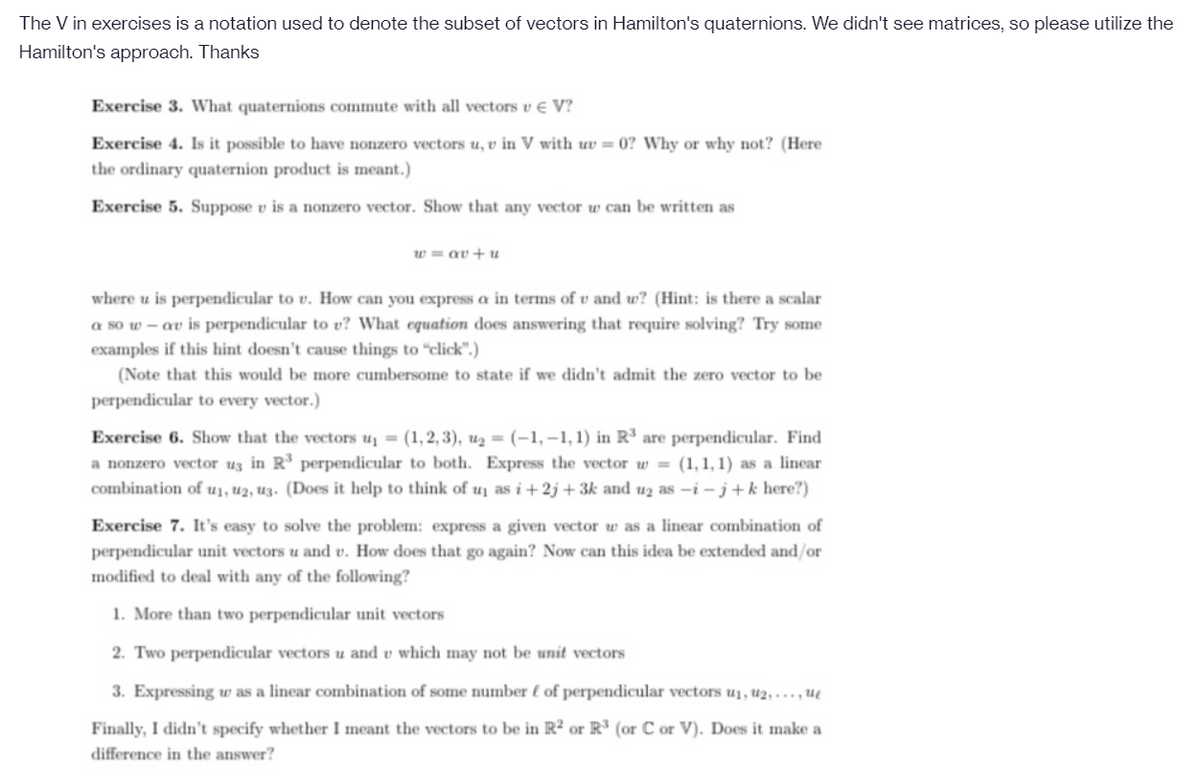Exercise 6. Show that the vectors uj = (1,2, 3), uz = (-1,–1,1) in R³ are perpendicular. Find a nonzero vector uz in R' perpendicular to both. Express the vector w = (1,1,1) as a linear combination of u1, u2, uz. (Does it help to think of uj as i+2j + 3k and uz as -i – j + k here?) %3D
Exercise 6. Show that the vectors uj = (1,2, 3), uz = (-1,–1,1) in R³ are perpendicular. Find a nonzero vector uz in R' perpendicular to both. Express the vector w = (1,1,1) as a linear combination of u1, u2, uz. (Does it help to think of uj as i+2j + 3k and uz as -i – j + k here?) %3D
Linear Algebra: A Modern Introduction
4th Edition
ISBN:9781285463247
Author:David Poole
Publisher:David Poole
Chapter6: Vector Spaces
Section6.2: Linear Independence, Basis, And Dimension
Problem 63EQ
Related questions
Question
solve exercies 6 with explanation asap

Transcribed Image Text:The V in exercises is a notation used to denote the subset of vectors in Hamilton's quaternions. We didn't see matrices, so please utilize the
Hamilton's approach. Thanks
Exercise 3. What quaternions commute with all vectors v e V?
Exercise 4. Is it possible to have nonzero vectors u, v in V with uv = 0? Why or why not? (Here
the ordinary quaternion product is meant.)
Exercise 5. Suppose v is a nonzero vector. Show that any vector w can be written as
w = av+u
where u is perpendicular to v. How can you express a in terms of v and w? (Hint: is there a scalar
a so w – av is perpendicular to v? What equation does answering that require solving? Try some
examples if this hint doesn't cause things to "click".)
(Note that this would be more cumbersome to state if we didn't admit the zero vector to be
perpendicular to every vector.)
Exercise 6. Show that the vectors u = (1,2, 3), u2 = (-1,–1,1) in R³ are perpendicular. Find
a nonzero vector uz in R perpendicular to both. Express the vector w = (1,1, 1) as a linear
combination of u1, u2, uz. (Does it help to think of u as i+2j + 3k and uz as -i– j+k here?)
Exercise 7. It's easy to solve the problem: express a given vector w as a linear combination of
perpendicular unit vectors u and v. How does that go again? Now can this idea be extended and/or
modified to deal with any of the following?
1. More than two perpendicular unit vectors
2. Two perpendicular vectors u and v which may not be unit vectors
3. Expressing w as a linear combination of some number l of perpendicular vectors u1, u2, ..., u
Finally, I didn't specify whether I meant the vectors to be in R² or R³ (or C or V). Does it make a
difference in the answer?
Expert Solution
This question has been solved!
Explore an expertly crafted, step-by-step solution for a thorough understanding of key concepts.
Step by step
Solved in 2 steps with 2 images

Recommended textbooks for you

Linear Algebra: A Modern Introduction
Algebra
ISBN:
9781285463247
Author:
David Poole
Publisher:
Cengage Learning

Elements Of Modern Algebra
Algebra
ISBN:
9781285463230
Author:
Gilbert, Linda, Jimmie
Publisher:
Cengage Learning,

Elementary Linear Algebra (MindTap Course List)
Algebra
ISBN:
9781305658004
Author:
Ron Larson
Publisher:
Cengage Learning

Linear Algebra: A Modern Introduction
Algebra
ISBN:
9781285463247
Author:
David Poole
Publisher:
Cengage Learning

Elements Of Modern Algebra
Algebra
ISBN:
9781285463230
Author:
Gilbert, Linda, Jimmie
Publisher:
Cengage Learning,

Elementary Linear Algebra (MindTap Course List)
Algebra
ISBN:
9781305658004
Author:
Ron Larson
Publisher:
Cengage Learning

Algebra & Trigonometry with Analytic Geometry
Algebra
ISBN:
9781133382119
Author:
Swokowski
Publisher:
Cengage

College Algebra
Algebra
ISBN:
9781305115545
Author:
James Stewart, Lothar Redlin, Saleem Watson
Publisher:
Cengage Learning